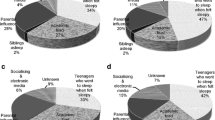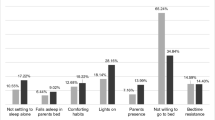Abstract
Sleep in children is essential for growth, emotional health and cognitive function. Although it has been described that poor sleep can seriously affect learning capacity, this relationship remains unclear. The purposes were to: (1) describe sleep patterns and sleep problems in schoolchildren; and (2) analyze the relationship between sleep quality and quantity and academic achievement. This study included 330 children aged 8–11 years and who had complete sleep data from 20 primary schools in 20 towns from the Cuenca province, Spain. The Spanish version of the Children’s Sleep Habits Questionnaire was used, and parents’ educational level, and academic achievement (final grades) were measured. Analysis of covariance models was used to assess differences in academic achievement by sleep problems and sleep duration categories, controlling for age and parents’ educational level. This study found that 6.1% of the children who participated in our study slept < 9 h/day, and 9.1% of them had sleep problems. Our results showed an inverse trend between sleeping < 9 h/day and having sleep problems with academic achievement, although these differences did not reach statistical significance (p > 0.05). In this study, a considerable proportion of the schoolchildren sleep less than recommended and have sleep problems. Sleep intervention may be important to prevent sleep problems and insufficient sleep in schoolchildren. Further research is needed to clarify the association of sleep insufficiency and problems with academic performance in schoolchildren.
Similar content being viewed by others
References
Tikotzky L, De Marcas G, Har-Toov J, Dollberg S, Bar-Haim Y, Sadeh A. Sleep and physical growth in infants during the first 6 months. J Sleep Res. 2010;19:103–10.
Wiater AH, Mitschke AR, Widdern SV, Fricke L, Breuer U, Lehmkuhl G. Sleep disorders and behavioural problems among 8- to 11-year-old children. Somnologie. 2005;9:210–4.
Dewald JF, Meijer AM, Oort FJ, Kerkhof GA, Bögels SM. The influence of sleep quality, sleep duration and sleepiness on school performance in children and adolescents: a meta analytic review. Sleep Med Rev. 2010;14(3):179–89.
Alfano CA, Zakem AH, Costa NM, Taylor LK, Weems CF. Sleep problems and their relation to cognitive factors, anxiety, and depressive symptoms in children and adolescents. Depress Anxiety. 2009;26:503–12.
Curcio G, Ferrara M, De Gennaro L. Sleep loss, learning capacity and academic performance. Sleep Med Rev. 2006;10:323–37.
Fricke L, Plück J, Schredl M, Heinz K, Mitschke A, Wiater A, et al. Prevalence and course of sleep problems in childhood. Sleep. 2007;30(10):1371–7.
Mindell JA, Owens JA. A clinical guide to pediatric sleep: diagnosis and management of sleep problems. 2nd ed. Philadelphia: Lippincott Williams & Wilkins; 2015.
Anders TF, Eiben LA. Pediatric sleep disorders: a review of the past 10 years. J Am Acad Child Adolesc Psychiatry. 1997;36:9–20.
Liu X, Liu L, Owens JA, Kaplan DL. Sleep patterns and sleep problems among schoolchildren in The United States and China. Pediatrics. 2005;115:241–9.
Latz S, Wolf AW, Lozoff B. Cosleeping in context: sleep practices and problems in young children in Japan and The United States. Arch Pediatr Adolesc Med. 1999;153:339–46.
Owens JA. Introduction: culture and sleep in children. Pediatrics. 2005;115:201–3.
National Sleep Foundation. Children and sleep. Arlington: National Sleep Foundation; 2015. https://sleepfoundation.org/sleep-topics/children-and-sleep/page/0/3. Accessed 16 Nov 2015.
Silva GE, Goodwin JL, Parthasarathy S, Sherrill DL, Vana KD, Drescher AA, et al. Longitudinal association between short sleep, body weight, and emotional and learning problems in Hispanic and Caucasian children. Sleep. 2011;34:1197–205.
Iwadare Y, Kamei Y, Oiji A, Doi Y, Usami M, Kodaira M, et al. Study of the sleep patterns, sleep habits, and sleep problems in Japanese elementary school children using the CSHQ-J. Kitasato Med J. 2013;43:31–7.
Firouzi S, Bee Koon P, Noor MI, Sadeghilar A. Sleep pattern and sleep disorders among a sample of Malaysian children. Sleep Biol Rhythm. 2013;11:185–93.
Jiang F, Yan C, Wu S, Wu H, Zhang Y, Zhao J, et al. Sleep time of children from 1 month to 5 years of age in Shanghai, an epidemiological study. Zhonghua yi xue za zhi. 2002;82:736–9.
Li S, Zhu S, Jin X, Yan C, Wu S, Jiang F. Risk factors associated with short sleep duration among Chinese school-aged children. Sleep Med. 2010;11(9):907–16.
Roberts RE, Roberts CR, Duong HT. Chronic insomnia and its negative consequences for health and functioning of adolescents: a 12-month prospective study. J Adolesc Health. 2008;42(3):294–302.
Meijer AM, Habekothe HT, Van Den Wittenboer GL. Time in bed, quality of sleep and school functioning of children. J Sleep Res. 2000;9:145–53.
Mayes SD, Calhoun SL, Bixler EO, Vgontzas AN. Nonsignificance of sleep relative to IQ and neuropsychological scores in predicting academic achievement. J Dev Behav Pediatr. 2008;29(3):206–12.
Galland BC, Taylor BJ, Elder DE, Herbison P. Normal sleep patterns in infants and children: a systematic review of observational studies. Sleep Med Rev. 2012;16:213–22.
Owens JA, Spirito A, McGuinn M. The children’s sleep habits questionnaire (CSHQ): psychometric properties of a survey instrument for school-aged children. Sleep. 2000;23:1043–51.
Lucas-de la Cruz L, Martínez-Vizcaino V, Álvarez-Bueno C, Arias-Palencia N, Sánchez-López M, Notario-Pacheco B. Reliability and validity of the Spanish version of the children’s sleep habits questionnaire (CSHQ-SP) in school-age children. Child Care Health Dev. 2016;42(5):675–82.
Canet T. Sleep–wake habits in Spanish primary school children. Sleep Med. 2010;11(9):917–21.
Orgilés M, Owens J, Espada JP, Piqueras JA, Carballo JL. Spanish version of the Sleep Self-Report (SSR): factorial structure and psychometric properties. Child Care Health Dev. 2013;39(2):288–95.
Martínez-Vizcaíno V, Sánchez-López M, Salcedo-Aguilar F, Notario-Pacheco B, Solera-Martínez M, Moya-Martínez P, et al. Protocolo de un ensayo aleatorizado de clusters para evaluar la efectividad del programa MOVI-2 en la prevención del sobrepeso en escolares [Protocol of a randomized cluster trial to assess the effectiveness of the MOVI-2 program on overweight prevention in schoolchildren]. Rev Esp Cardiol. 2012;65(5):427–33.
Álvarez C, Alonso J, Domingo A, Regidor E. La medición de la clase social en ciencias de la salud. Barcelona: SG Editores; 1995.
Van Litsenburg RRL, Waumans RC, Van den Berg G, Gemke RJ. Sleep habits and sleep disturbances in Dutch children: a population-based study. Eur J Pediatr. 2010;169(8):1009–15.
Yang QZ, Bu YQ, Dong SY, Fan SS, Wang LX. A comparison of sleeping problems in school-age children between rural and urban communities in China. J Paediatr Child Health. 2009;45:414–8.
Wang G, Xu G, Liu Z, Lu N, Ma R, Zhang E. Sleep patterns and sleep disturbances among Chinese school-aged children: prevalence and associated factors. Sleep Med. 2013;14(1):45–52.
Abou-Khadra MK. Sleep patterns and sleep problems among Egyptian school children living in urban, suburban, and rural areas. Sleep Biol Rhythm. 2009;7:84–92.
Liu X, Kurita H, Uchiyama M, Okawa M, Liu L, Ma D. Life events, locus of control, and behavioral problems among Chinese adolescents. J Clin Psychol. 2000;56:1565–77.
Guérin N, Reinberg A, Testu F, Boulenguiez S, Mechkouri M, Touitou Y. Role of school schedule, age, and parental socioeconomic status on sleep duration and sleepiness of Parisian children. Chronobiol Int. 2001;18(6):1005–17.
Ahmad RH. Educational development and reformation in Malaysia: past, present and future. J Educ Adm. 1998;36(5):462–75.
Yusoff MSB. Stress, stressors & coping strategies among secondary school students in a Malaysian government secondary school: initial findings. ASEAN J Psychiatry. 2010;11(2):1–15.
Cain N, Gradisar M. Electronic media use and sleep in school-aged children and adolescents: a review. Sleep Med. 2010;11(8):735–42.
Adan A, Natale V. Gender differences in morningness–eveningness preference. Chronobiol Int. 2002;19:709–20.
Lehnkering H, Siegmund R. Influence of chronotype, season, and sex of subject on sleep behavior of young adults. Chronobiol Int. 2007;24(5):875–88.
Acknowledgements
This work was supported by the Ministry of Education and Science-Regional Government of Castile-La Mancha (PII1I09-0259-9898 and POII10-0208-5325), and Ministry of Health (FIS PI081297). Additional funding was obtained from the Research Network on Preventative Activities and Health Promotion (Ref. RD06/0018/0038).
Author information
Authors and Affiliations
Corresponding author
Ethics declarations
Conflict of interest
On behalf of all authors, the corresponding author states that there is no conflict of interest.
Additional information
Publisher's Note
Springer Nature remains neutral with regard to jurisdictional claims in published maps and institutional affiliations.
Electronic supplementary material
Below is the link to the electronic supplementary material.
Rights and permissions
About this article
Cite this article
Torrijos-Niño, C.E., Pardo-Guijarro, M.J., Martínez-Vizcaíno, V. et al. Sleep patterns and sleep problems in a sample of Spanish schoolchildren. Sleep Biol. Rhythms 18, 331–341 (2020). https://doi.org/10.1007/s41105-020-00277-7
Received:
Accepted:
Published:
Issue Date:
DOI: https://doi.org/10.1007/s41105-020-00277-7




